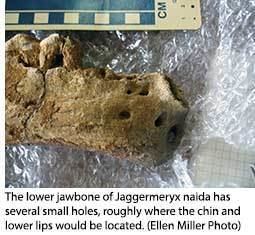Scientific name Jaggermeryx naida Rank Species | Genus †Jaggermeryx Phylum Chordata Order Even-toed ungulate | |
 | ||
Similar Aleiodes shakirae, Aegrotocatellus, Anthracotheriidae, Gnathia marleyi, Bumba lennoni | ||
Jaggermeryx is an extinct genus of semiaquatic anthracothere, ungulates related to hippopotamuses, from early Miocene Africa. The genus was named after Mick Jagger.
Contents
Discovery
The first fossils of the species were described in a monograph published by a French scientist in 1918. It was not until 2014, however, that the fossils were identified as a unique species from further specimens collected at Wadi Moghra in the Qattara Depression of Egypt. The fossils have been deposited at the Cairo Geological Museum, Cairo University, and Duke University.
At the site, six species of anthracotheres were discovered, but this sample was unlike other family members because of "a series of tiny holes on either side of its jaw that held the nerves providing sensation to the chin and lower lip."
The National Science Foundation supported the research.
Etymology
The species name, Jaggermeryx naida, literally translates as "Jagger's water nymph". It was named after Mick Jagger, lead singer for The Rolling Stones, because of its oversized lips. There was some debate among the team as to whether it should instead be named after Angelina Jolie. "Some of my colleagues suggested naming the new species after Hollywood star Angelina Jolie, because she also has famous lips," said lead author Ellen Miller. It was eventually settled to name the species after Jagger when co-author Gregg Gunnell sided with Miller.
Description
The size of a small deer, J. naida probably looked somewhat like a skinny hippopotamus out-crossed with a long-legged pig. Fossilized jawbones contain a number of mental foramina, eight on each side of the jaw, indicating that the species had very sensitive lips and a mobile snout.
Habitat
J. naida lived in the Qattara Depression around 19 million years ago, during the early Miocene. At that time the area, which is currently arid, was a tropical swamp. Jaggermeryx fossils have been found alongside those of catfish, turtles, and waterbirds, as well as six other species of anthracotheres and a number of crocodile coprolites.
Paleobiology
The species was herbivorous, feeding on grasses and plants beside the water. Judging by the low oxygen isotope values of its teeth, J. naida is believed to have been semiaquatic, likely spending most of the time when it was not feeding in the water, not unlike a hippopotamus.
